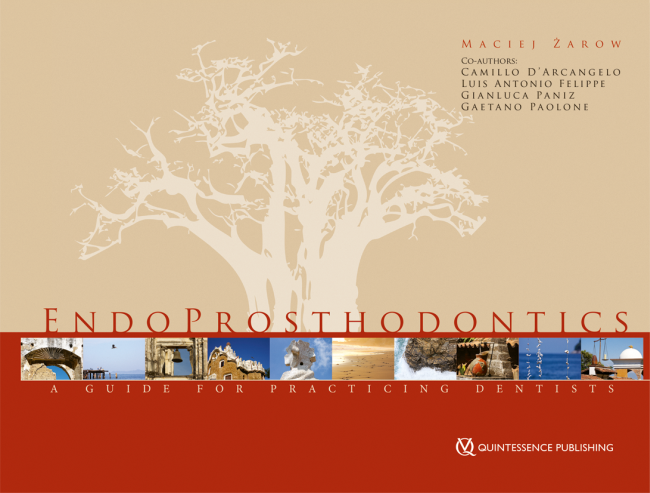The Journal of Adhesive Dentistry, 4/2012
DOI: 10.3290/j.jad.a22765, PubMed ID (PMID): 22282760Pages 377-384, Language: EnglishD'Arcangelo, Camillo / De Angelis, Francesco / Vadini, Mirco / Carluccio, Fabio / Vitalone, Laura Merla / D'Amario, MaurizioPurpose: To assess the microhardness of three resin composites employed in the adhesive luting of indirect composite restorations and examine the influence of the overlay material and thickness as well as the curing time on polymerization rate.
Materials and Methods: Three commercially available resin composites were selected: Enamel Plus HRI (Micerium) (ENA), Saremco ELS (Saremco Dental) (SAR), Esthet-X HD (Dentsply/DeTrey) (EST-X). Post-polymerized cylinders of 6 different thicknesses were produced and used as overlays: 2 mm, 3 mm, 3.5 mm, 4 mm, 5 mm, and 6 mm. Two-mm-thick disks were produced and employed as underlays. A standardized amount of composite paste was placed between the underlay and the overlay surfaces which were maintained at a fixed distance of 0.5 mm. Light curing of the luting composite layer was performed through the overlays for 40, 80, or 120 s. For each specimen, the composite to be cured, the cured overlay, and the underlay were made out of the same batch of resin composite. All specimens were assigned to three experimental groups on the basis of the resin composite used, and to subgroups on the basis of the overlay thickness and the curing time, resulting in 54 experimental subgroups (n = 5). Forty-five additional specimens, 15 for each material under investigation, were produced and subjected to 40, 80, or 120 s of light curing using a microscope glass as an overlay; they were assigned to 9 control subgroups (n = 5). Three Vicker's hardness (VH) indentations were performed on each specimen. Means and standard deviations were calculated. Data were statistically analyzed using 3-way ANOVA. Within the same material, VH values lower than 55% of control were not considered acceptable.
Results: The used material, the overlay thickness, and the curing time significantly influenced VH values. In the ENA group, acceptable hardness values were achieved with 3.5-mm or thinner overlays after 120 or 80 s curing time (VH 41.75 and 39.32, respectively), and with 2-mm overlays after 40 s (VH 54.13). In the SAR group, acceptable hardness values were only achieved with 2-mm-thick overlays after 120 or 80 s curing time (VH 39.81 and 29.78, respectively). In the EST-X group, acceptable hardness values were only achieved with 3-mm or thinner overlays, after 120 or 80 s curing time (VH 36.20 and 36.03, respectively).
Conclusion: Curing time, restoration thickness, and overlay material significantly influenced the microhardness of the tested resin composites employed as luting agents. The clinician should carefully keep these factors under control.
Keywords: indirect composite restoration, luting, Vickers hardness
International Journal of Periodontics & Restorative Dentistry, 5/2011
PubMed ID (PMID): 21845250Pages 557-562, Language: EnglishGarocchio, Santo / Camaioni, Emanuele / Di Felice, Roberto / De Dominicis, Alessandro / D'Amario, Maurizio / D'Arcangelo, Camillo / Giannoni, MarioThis report presents a new clinical protocol that facilitates the diagnostic, surgical, and prosthetic phases of immediately loaded implant rehabilitations. The proposed technique aims to simplify recording of the centric relation, which is usually done immediately after surgery, during the surgical impression phase. This shortens operative time while meeting requirements for an accurate impression and is thus simple and cost effective. The case report of a maxillary full-arch immediately loaded implant rehabilitation in a 45-year-old patient illustrates the clinical steps in the proposed procedure and confirms its repeatability.
International Journal of Periodontics & Restorative Dentistry, 1/2011
PubMed ID (PMID): 21365027Pages 57-65, Language: EnglishDi Felice, Roberto / D'Amario, Maurizio / De Dominicis, Alessandro / Garocchio, Santo / D'Arcangelo, Camillo / Giannoni, MarioEndosseous dental implants have revolutionized the methods clinicians use to treat edentulous and partially edentulous patients. Traditional implant protocol specifies a healing period of several months after tooth extraction, as well as an unloaded healing period prior to restoration. Over the last decade, numerous studies have documented successful immediate placement of endosseous dental implants in fresh extraction sites and have found positive results with early functional loading. The purpose of this article is to present a clinical treatment protocol for the immediate placement and early loading of dental implants and to report the clinical and radiographic outcomes of the SLActive surface Straumann Bone Level implant placed in either maxillary or mandibular fresh extraction sockets.
The Journal of Adhesive Dentistry, 2/2009
DOI: 10.3290/j.jad.a15322, PubMed ID (PMID): 19492712Pages 109-115, Language: EnglishD'Arcangelo, Camillo / Vanini, Lorenzo / Prosperi, Gianni Domenico / Di Bussolo, Giulia / De Angelis, Francesco / D'Amario, Maurizio / Caputi, SergioPurpose: To evaluate the effects of multiple adhesive layers of three etch-and-rinse adhesives on both adhesive thickness and microtensile bond strength (µTBS).
Materials and Methods: Midcoronal occlusal dentin of 36 extracted human molars was used. Teeth were randomly assigned to 3 groups (EB, XP, PQ) according to the adhesive system to be used: PQ1 (Ultradent) (PQ), EnaBond (Micerium) (EB), or XP Bond (Dentsply/DeTrey) (XP). Specimens from each group were further divided into three subgroups according to the number of adhesive coatings (1, 2, or 3). In all subgroups, each adhesive layer was light cured before application of each additional layer. After bonding procedures, composite crowns were incrementally built up. Specimens were sectioned perpendicular to the adhesive interface to produce multiple beams, approximately 1 mm2 in area. Beams were tested under tension at a crosshead speed of 0.5 mm/min until failure. Adhesive thicknesses and failure modes were evaluated with SEM. The µTBS data and mean adhesive thickness were analyzed by two-way ANOVA and multiple-comparison Tukey's test (α = 0.05).
Results: The mean bond strength (in MPa (SD)) of group EB gradually increased from 1 to 3 consecutive coatings (27.02 (9.38) to 44.32 (4.93), respectively) (p 0.05). The highest mean bond strengths for the PQ (46.66 (12.95)) and XP groups (40.55 (5.69)) were obtained applying two adhesive coatings. The mean thickness of the adhesive layer (in µm (SD)) significantly increased with the number of coatings (p 0.05), ranging from 29.45 (1.42) to 77.64 (1.10) for PQ, from 5.12 (0.68) to 37.75 (0.92) for EB, and from 12.64 (0.68) to 37.92 (0.71) for the XP group. Failure modes for EB specimens were mainly classified as adhesive failure between adhesive and dentin. The XP3 and PQ3 subgroups showed a greater number of total cohesive failure in adhesive.
Conclusion: Multiple adhesive coats significantly affected bond strength to dentin. An excess of adhesive layer thickness can negatively influence the strength and the quality of adhesion.
Keywords: dentin adhesive, adhesive layer, microtensile bond strength, SEM
The Journal of Adhesive Dentistry, 3/2007
DOI: 10.3290/j.jad.a12391, PubMed ID (PMID): 17655072Pages 319-326, Language: EnglishD'Arcangelo, Camillo / Vanini, LorenzoPurpose: To evaluate the effect of different surface treatments of composite resin blocks on the adhesive properties of indirect composite restorations. The null hypothesis tested was that none of the performed surface treatments would produce greater bond strength.
Materials and Methods: The crowns of 80 extracted molars were transversally sectioned next to the pulp to expose flat, deep dentin surfaces. Eighty-eight cylindrical composite specimens measuring 3.5 mm in diameter and 10 mm in height were prepared and randomly divided into 4 groups (CG, HFSiG, SaG, SaSiG), which respectively received the following treatments: control (CG): etching with 9.5% HF acid gel and application of a silane (HFSiG); sandblasting (SaG) with 50- µm Al2O3 from a distance of 10 mm at a pressure of 2.5 bars for 10 s; combination of sandblasting and silanization procedures (SaSiG). Two composite specimens of each group were analyzed with SEM, while the remaining twenty cylindrical specimen were bonded to dentin samples using a two-step adhesive system and a thin layer of composite. After 24 h storage and 5000 thermocycles, all specimens were loaded to failure under tension in a universal testing machine. The mean differences of each group were analyzed with the Kruskal-Wallis test, while multiple comparisons were made using the Ryan-Einot-Gabriel-Welsch Range test. P-values less than 0.05 were considered to be statistically significant in all tests. The fracture pattern of bonded specimens was also evaluated by SEM.
Results: SEM analysis showed morphological changes in each group. The mean values (in MPa) of TBS (± SD) for groups CG, HFSiG, SaG, and SaSiG were 11.17 ± 3.48, 10.81 ± 5.19, 16.51 ± 3.45 and 16.55 ± 3.16, respectively. Statistical analysis showed that the bond strength was significantly affected by surface treatment (p 0.001). Multiple comparison analysis identified statistically significant differences for CG and HFSiG vs SaG and SaSiG (p 0.05), while no significant differences were found for the comparisons CG vs HFSiG and SaG vs SaSiG (p > 0.05). Only a few adhesive failures were recorded (CG: 0.5%; SaG: 0.4%; HFSiG: 0.5%; SaSiG: 0.7%). The null hypothesis was rejected.
Conclusion: Composite surface treatments are important for adhesion of indirect composite restorations. Roughening the composite area of adhesion, sandblasting, or both sandblasting and silanizing can provide statistically significant additional resistance to tensile load. Hydrofluoric acid etching with silane treatment did not reveal significant changes in tensile bond strength. These findings suggest that sandblasting treatment was the main factor responsible in improving the retentive properties of indirect composite restorations.
Keywords: tensile bond strength, composite, surface treatments




